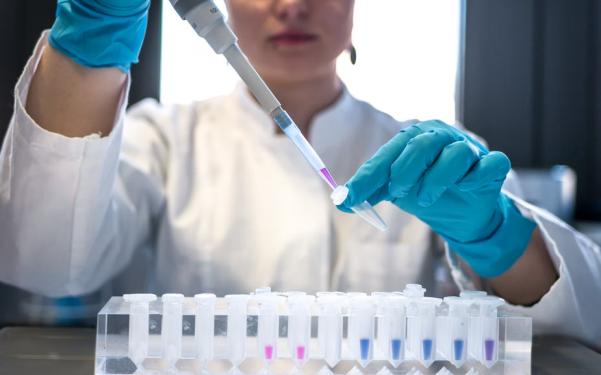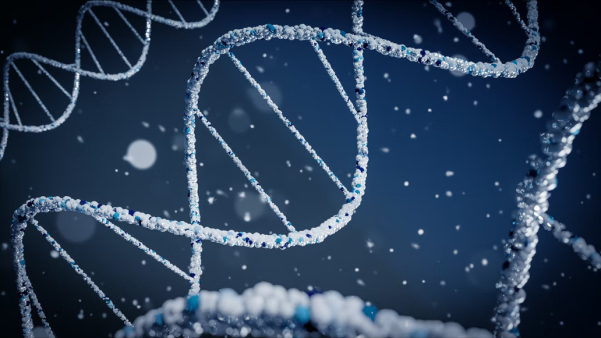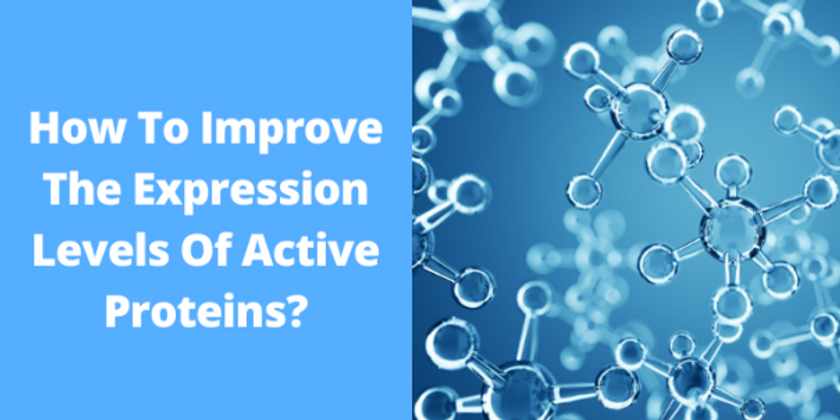How To Improve The Expression Levels Of Active Proteins?
Apr 21st 2022
Recombinant protein purification and expression for potent development can be a recurring challenge. Such a procedure requires a significant investment in cost and time to acquire high yields of active and refined recombinant proteins. The primary objective of this post is to present a brief list of tips demonstrating how to enhance and improve the expression levels of active proteins.
E. Coli is one of the most broadly utilized protein production units for potent target research. Besides, the process comprises several benefits since bacterial protein production service is relatively less costly and might quickly produce proteins. When it concerns the analytical background of a specified protein's physicochemical and biological properties, an investigator has to keep it as the vantage point in their mind before proceeding. One can achieve this by utilizing a specific software or bioinformatic source. It is also essential to know that these instruments enable a researcher to analyze primary sequences and observe if all of it is in the correct order.

In addition, such software and resources can also predict tertiary and secondary domain structures, signal peptide localization, solubility, potential disorder zones, stability, and hydrophobicity. Considering the insight, one can acknowledge the experimental method they need to adopt. Once you have accumulated all this available information or when you identify complex proteins, there are vital parameters you need to implement to optimize or improve recombinant proteins in E. Coli. Similarly, this applies to custom antibody production and custom protein expression. So, let's get started with this custom protein synthesis.
The design of expression vectors
The development of expression plasmids needs numerous elements whose arrangement or organization must be seamlessly considered to ensure the highest levels of proteins are synthesized. The crucial structure of the expression vector of the custom antibody moves to a constructive position where it can be upstreamed.
When placing a promoter between 10 to 100 bp ahead of the RBS, it might integrate into the vector and control the regulatory genes. As a result, promoters of this test include hexanucleotide sequences placed around 35 bp upstream of the entire transcription base, which sums up to 235 regions. Later, you can separate it with a short spacer from other hexanucleotide sequences.
Moreover, several promoters are present for gene expression, comprising those extracted or procured from gram-positive bacteriophages and bacteria. Consequently, a beneficial promoter showcases many desirable elements, robust with low basal expression levels. If you are operating on it, you can quickly transfer it to the E. Coli strains to accommodate testing of a considerable number of strains for protein yields. In the end, its induction is relatively cheap and straightforward.
Considering the area between the codon ranges and SD sites, they can fall between 5 to 13 bases, allowing other sequences of this area to eliminate the possibility of tertiary or secondary formation in the mRNA transcript. Such a method can alleviate the effectiveness of translation commencement. Both 3∩ and 5∩ areas of the RBS might demonstrate a specific bias towards high adenine contents. Deeper into the process, a researcher may observe the transcription terminator in the sequence downstream, serving as a potent signal to conclude transcription processes and act as a protective component composed of stem-loop formations.

One of the studies states that, in addition to all the elements, the direct impact of the effectiveness of gene expression and antibody production plays a significant role in determining the potential vectors. Furthermore, this could include genes that may confer antibiotic resistance on the surface of the host to support plasmid propagation and selection. At length, a plasmid's copy number is accommodated by the replication origin. However, in some cases, the utilization of replicons might lead to considerable quantification of plasmid copy numbers with higher yields found in the plasmid-encoded proteins.
Here, the final average of protein synthesis will usually rely on promoter strength, gene dosage, the efficiency of translation initiation, and mRNA stability.
The use of codons
Researchers have encoded most amino acids with more than a single codon in recent times. In addition, their codons are bias used by every organism. But, when it comes to tRNA oo cells, it may reflect the codon bias of the mRNA. Codon usage observation reveals that highly expressed genes can exhibit considerable codon bias compared to poorly expressed genes. This also expresses the frequency of synonymous codons utilized amid the cognate tRNAs.
These imply that heterologous genes with several forms of codons, rarely utilized in E. Coli, might not be effectively expressed and result in translation errors. The codon bias becomes relatively more distinctive when rare codons from clusters like triplets or doublets tend to accumulate in substantial quantities. In such a process, rare codon translation errors include mistranslation of amino acids, premature translational termination, and frameshifting events.
Consider protein folding
Meanwhile, the E. Coli expression system is primarily redirected to 3 other locations: the cytoplasm, the growth medium, and the periplasm (through secretion). Additionally, a researcher may opt for cytoplasmic expression since the resulting yields are on the higher side. On the other hand, cytoplasmic folding is subjected to meager temperatures because of the use of cold enhancements. This is coupled with segregation and misfolding into insoluble aggregates called inclusion bodies.
It is essential to know that one can reduce aggression to its bare minimum through parameter control like expression percentage, temperature, and host metabolism. Even though the formation of an inclusion body accommodates seamless protein purification, there's no such guarantee that the in vitro folding would produce a considerable number of active end-products. Investigators have studied various growth mediums to deliver recombinant proteins into the growth medium. While it is a complex approach, you won't find it on the commercial market.
Consider adapted bacterial strains
To improve the quality and quantity of proteins developed in E. Coli, numerous methods and approaches with innovative processes have come into play in the last decade. Many tools are now present worldwide with plenty of bacterial strains with particular characteristics. Researchers adhere to these to produce toxic or membrane proteins, proteins with rare codons, or disulfide bonds.
Expression vector
While expediting the production of active proteins, one must know that expression vectors consist of several promoters, cloning platforms, specific markers, and fusion proteins. The amount of plasmids present in the industrial market is substantial. Consequently, selecting the correct ones for recombinant protein expressions is one of the most challenging ones. That's because every promoter comes with various characteristics like:
- Lac promoter - It is an integral constituent component. Instances of industrial plasmids utilizing tac or lac promoters to maneuver protein expression cycles are the pUC series along with the pMAL vector series.
- T7 promoter - This promoter is available with the pET vectors, which are highly popular for recombinant protein expression procedures. Since this isn't surprising, one of the target proteins can represent around 50% of the entire cell protein in fortunate cases. In such a system, the gene gets cloned beneath a promoter recognized by T7 RNAP.
- Ara promoter - Researchers utilize this promoter in the shape of positive control since it comprises lower expression levels - for example, the PBAD promoters amid pBAD vectors. Primarily, AraC proteins have dual roles as repressors/activators.
- pL promoters - Investigators producing active expression vectors use such promoters widely. Moreover, the gene of interest is influenced by regulated phage promoters.
Optimize the codons

Most amino acids get encoded through several available codons, implying that multiple tRNAs accord with a single batch of amino acids. Consequently, many redundant tRNAs are more in numbers than the rest coding for corresponding amino acids in specific cells. When it concerns codon optimization, it can switch every codon used amid the transgene in the absence of transforming or triggering the sequence that it codes for. Furthermore, this increases the number of proteins because it can eliminate rare sequences of codons and replace them with those available in the host organism.
Nonetheless, such an effect is not comprehensively profitable for every target protein in a few instances. This is because researchers accept it widely, optimizing the codon of the specific gene in the selected heterologous expression procedures. Researchers perform these protein expression techniques to improve and optimize the translation rate through natural ratio exploitation in the tRNAs.
However, the mRNA elongation is one of the irregular processes where the speed seems to be associated with modulating the schedule required to enable the right domain folding. If you aren't aware, the folding occurs in multi-domain proteins. When a researcher moves to optimize the codon usage, it implies increasing the elongation tempo through significant sequences. Besides, it would be best if you produced novel algorithms to consider such a challenge.
Lower expression temperatures
In the modern age of biosciences, researchers utilize bacterial cultivation at controlled temperatures to alleviate protein aggregation. Moreover, this slows the rate of protein synthesis, further decreasing every hydrophobic interaction associated with protein self-aggregation. In addition, low temperatures might also alleviate or impair the degradation of protein because of substandard activities of heat shocks that are typically induced during the process of overproduction.
However, such a procedure has some disadvantages, as temperature depletion might affect transcription and translation estimates, besides alleviating the build-up of protein production and bacterial development. Nonetheless, these constraints can be bypassed by utilizing cold-inducible promoters that could increase protein production under low temperatures. Since individuals can't access this step, consult companies offering antibody production services, peptide synthesis, gene synthesis, antibody sequencing services, and custom protein synthesis.
Produce protein in specific media surroundings
Enhancing recombinant protein expression can be carried out through the additives' composition and culture media. In this case, multiple experimental conditions become a part of the R&D facilities where researchers optimize proteins. In addition, they cater to these optimization cycles by accommodating an ideal bacterial growth medium mixture. If you wonder about the MBP tags, one can perform them on viral proteins associated with 62 kDa, that's typically unstable with the following elements:
- A couple of predictive unfolded disorder zones
- Hydrophobic cores
- Four disulfide bonds
Support stabilizing sequences
You can add various tags to support stabilizing sequences to enhance purification effectiveness and protein solubility.
Big stabilizing and solubilizing tags

Did you know that adding the fusion tags at the C- or N- or terminal protein part is easier? On the other hand, the initial tags developed to improve the protein's solubilities were LacZ and protein A with more than 200 amino acids. Later during that stage, you can develop and produce many tags to make them available to experts. Furthermore, Fh8 and Strep II-tag, which are meager tags of eight and ten amino acids, can also enhance protein solubility. Moreover, the Strep II tag doesn't intervene with membrane or protein folding translocations.
As a result, a suitable way to move ahead is to perform HTS screening to ensure different tags are efficient for your target proteins.
Small proteins associated with single amino acids
Peptide sequences comprising limited amino acid types are not only beneficial to overcoming the issue related to protein solubility but also a subject of amplifying the aggregation, adhesive, polymerization, and amino acids' solubility properties amid the C-terminus part of the protein.
Co-expressing molecular bondings
One of the primary drawbacks of the selected E. Coli expression system is the lack of PTMs or post-translational modifications. These changes have an essential role in protein function that may hinder your ability to produce or improve expression levels of active proteins.
Moreover, acknowledging interacting sequences of specific peptides can also assist in folding proteins that have had a seamless impact on protein solubilization, confrontation, and activity. For instance, co-expressing proteins of interest with human kinase 1 tend to induce the protein of interest's phosphorylation.
The bottom line
In the end, solutions can exist by considering a protein's specific physio-chemistry, efficient design of experiment (DoE), integrating modern strategies, or utilizing innovative reagents. Furthermore, an investigator should understand the factors involved in improving the expression levels of active proteins. However, if you're not aware of what is recombinant protein and how to adhere to recombinant protein expression systems, consult experts who can offer protein expression and purification services or deal in ELISA kits and profound monoclonal antibody sequencing.
References:
- https://www.frontiersin.org/articles/10.3389/fmicb.2014.00172/full
- https://www.ncbi.nlm.nih.gov/pmc/articles/PMC4127093/
- https://www.sciencedirect.com/topics/biochemistry-genetics-and-molecular-biology/protein-expression-level
- https://bmcbiotechnol.biomedcentral.com/articles/10.1186/s12896-019-0542-6

